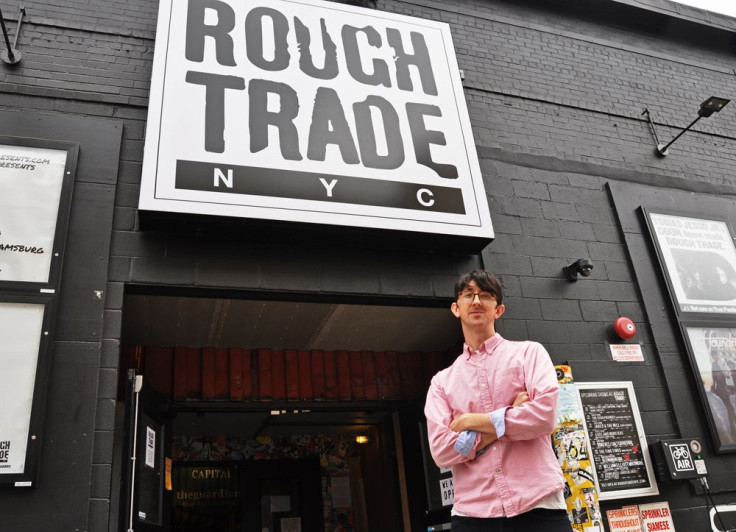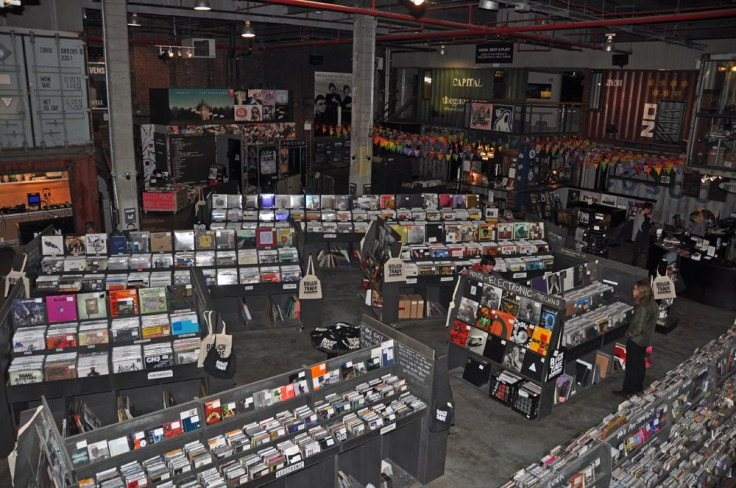Record Store Day 2015: How Merchants Rock On In An Era Of Streaming And Digital Downloads

With purple hair, a black leather jacket and bright orange leggings that taper into a pair of spikey boots, Elizabeth Simmons is a natural fit in New York’s East Village. As the 29-year-old stylist browses through a crate of used vinyl LPs in front of A-1 Record Shop on a sunny Thursday afternoon, she explains why she lugged her bulky 1980s-era hi-fi stereo system along with her when she moved to the city from a Minneapolis suburb six years ago.
“I inherited this big box of records and the stereo from my dad about 10 years ago,” Simmons says, her hand dipped into a blue crate of albums on the sidewalk. “I know people sometimes say it’s bull---- that records sound better than digital, but I think they do.”
Simmons has since replaced her father’s record collection with an eclectic mix of classic soul, electronic dance music, funk and hip-hop. She’s one of an increasing number of Americans devoted to a revival of vinyl-record collecting. The hobby has helped thousands of stores such as the A-1 Record Shop stay alive in an era of online single-click shopping convenience.
Digital downloading and streaming have pummeled brick-and-mortar music retailers during the past decade, but the record stores that remain are wooing customers by turning themselves into vinyl boutiques, concert venues, accessory shops and cafes, as they attempt to become hubs of activity for communities of loyal music listeners.
While record-store openings have seen a slight post-recession uptick in the U.S., online retailing in multiple audio formats, music-streaming services such as Spotify and digital file sharing continue to batter sales of physical musical formats such as CDs and vinyl. Total U.S. whole album sales -- both physical and digital -- dropped 11 percent to 257 million units last year, according to music-market tracker Nielsen. Even digital single-track sales retreated by almost 13 percent, to 1.26 billion downloads, as consumers shift to the subscription streaming format that has riled artists who say they make a pittance in streaming royalties.
This Saturday, hundreds, maybe thousands, of small outlets across the U.S. are celebrating Record Store Day, an event founded in 2007 by a group of independent store owners as a way to revive interest in browsing records in a shop instead of on a website. The day brings together the stores’ owners, recording artists and music fans with hundreds of exclusive CD and vinyl releases, as well as in-store performances.
Shopkeepers say the event has grown to become bigger in sales-revenue terms than the day after Thanksgiving, or Black Friday, the single most important shopping day in the U.S.
“Black Friday is big, but we’ll do more business on Saturday,” says Chris Vanderloo, co-owner of Other Music, a 20-year-old record shop located near the former Tower Records’ flagship store that once beckoned Greenwich Village shoppers. Tower went under nine years ago, and the location is now a licensed Major League Baseball outlet. “We’ll do the same business on Saturday as we do in more than a week.”
Will Muir, manager of Guestroom Records, a three-store chain founded in Norman, Oklahoma, in 2005, estimates Record Store Day is equivalent to a month’s worth of sales for the chain’s outlets in Norman, Oklahoma City and Louisville, Kentucky. For a small business that generates only about $1.25 million in annual revenue, that extra “month” goes a long way toward covering the annual cost of business operations.
In 2003, there were about 16,400 outlets in the U.S. for buying music in physical format, mostly CDs, according to data from the market-research firm Almighty Music Marketing. Due in part to the closing of Tower Records in 2006 and Virgin Megastores in 2009, the number of outlets now stands at about 9,200, including big-box retailers such as Target and Walmart, which have been scaling down their music offerings, Almighty’s data indicate.
But the 44 percent drop in music retail outlets over the past dozen years has slowed since the Great Recession. Between 2008 and 2015, 346 stores opened, and at a faster pace -- 18 in 2009 and 90 last year. Almighty found most of them are independent outlets or shops in small chains such as Guestroom Records.
“You can see how the growth correlates directly with the vinyl renaissance of recent years and the growth of Record Store Day,” says Almighty President Vince Hans, who points to the loss of big-box retailers such as Circuit City (in 2009) and Borders (in 2011), as well as the shrinking music inventories at Best Buy and Target, as an opportunity for small-business owners. He says they can offer what online retailers can’t: personality, face-to-face interactions and a sense of community around the ritual of enjoying music.
“Suddenly, many smaller cities found themselves with absolutely no place for a consumer to browse and purchase CDs and LPs, so that void is being filled by these new indie stores opening up,” says Hans.

Record stores have always been a meeting place for audiophiles to trade music recommendations and to check out in-store bulletin boards full of posters advertising forthcoming shows or local bands seeking drummers. Today, the need to create a community space is more important than ever because it’s perhaps the only way to lure customers away from Amazon.com, iTunes and the darker file-sharing crevices of the Internet, such as the Pirate Bay.
George Flanagan, co-manager of Rough Trade NYC, the Brooklyn-based outpost of the London record store that rose to fame during the British punk scene of the late 1970s, says his outlet is hosting seven live performances Saturday at its 300-person venue. Kim Gordon, the godmother of New York’s alternative rock scene who co-founded Sonic Youth, will sign copies of her new memoir there. Rough Trade’s event exemplifies what many record stores are doing to push back against the seemingly insurmountable challenges of shifting consumer habits.
Most young Americans don’t collect vinyl. For a small group of audiophiles, however, the record store is the preferred place to buy music.
“Vinyl has become way more popular,” says Muir of Guestroom Records. “When we opened [in 2005], about 30 percent of our sales were vinyl and the rest were mainly from CDs. That has completely flip-flopped in the last four to five years. Now about 75 percent of our sales are vinyl.” And these customers aren’t just jazz nerds and hipsters with obscure tastes. Muir says he’s received numerous requests recently for a vinyl version of hip-hop artist Kendrick Lamar’s 2015 release “To Pimp a Butterfly.” But so far, Lamar’s label Interscope Records, owned by the Universal Music Group, has yet to announce plans to release the album on vinyl.
“My guess is the labels are still gauging what kind of customer wants a vinyl release,” Rough Trade’s Flanagan says. “Vinyl is still a very small part of the market, but I think the story is the growth. And for an area like ours there are a lot of customers into that.”
Whether this growth is enough to stop the hemorrhaging of physical music sales is a big and important unknown for record stores. But, Saturday, storeowners will set aside these concerns and reap some bounty from their loyalists.
© Copyright IBTimes 2024. All rights reserved.






















